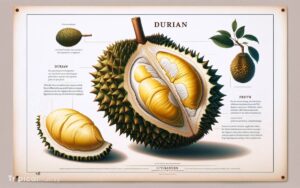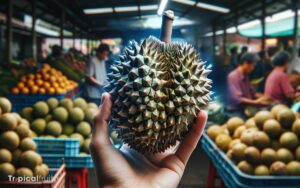Where Is Durian Fruit from? Unveiling the Origins!
The durian fruit is native to Southeast Asia, with the majority of durian production occurring in Thailand, Malaysia, and Indonesia.
Durian, known as the “King of Fruits,” has its origins deeply rooted in Southeast Asia, where it has been cultivated for hundreds of years.
It flourishes in the tropical climates of countries within this region. The fruit is distinctive for its large size, unique odor, and formidable thorn-covered husk.
Despite its polarizing smell, which some find overpowering and unpleasant, durian is prized for its rich, custard-like texture and complex flavor, often described as a combination of sweet, savory, and creamy.
Key Facts about Durian Fruit:
Revered in Southeast Asia, the durian fruit’s unique aroma and flavor profile have secured its reputation as a culinary delicacy in the region and beyond.
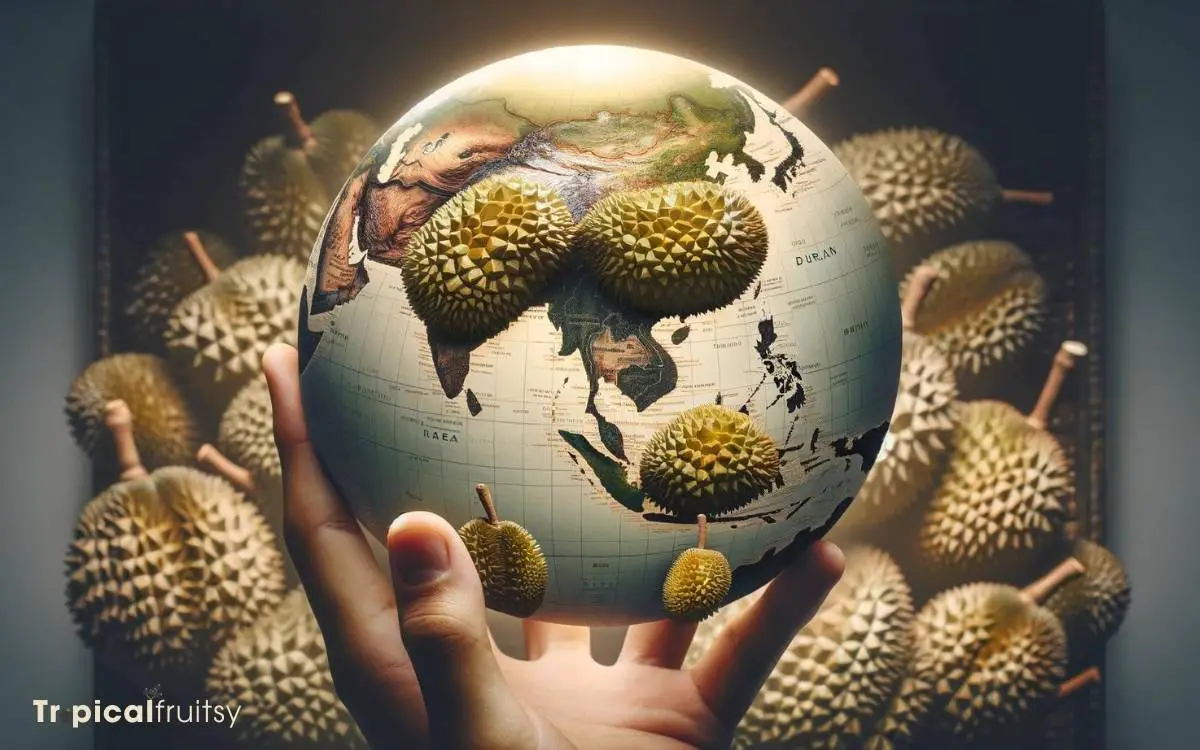
Key Takeaway
The Native Origins and Global Spread of Durian Fruit
| Country | Climate Conditions | Role in Durian Cultivation |
|---|---|---|
| Malaysia | Hot and humid, heavy rainfall | Native and major cultivator |
| Indonesia | Equatorial, ideal for tropical fruits | Native habitat; large-scale cultivation |
| Brunei | Tropical rainforest climate | Indigenous to the region |
| Thailand | Warm and wet tropical | Major exporter of durian |
| Philippines | Humid and tropical | Growing durian production |
| Vietnam | Tropical monsoon | Increasing durian cultivation |
Durian’s Southeast Asian Roots
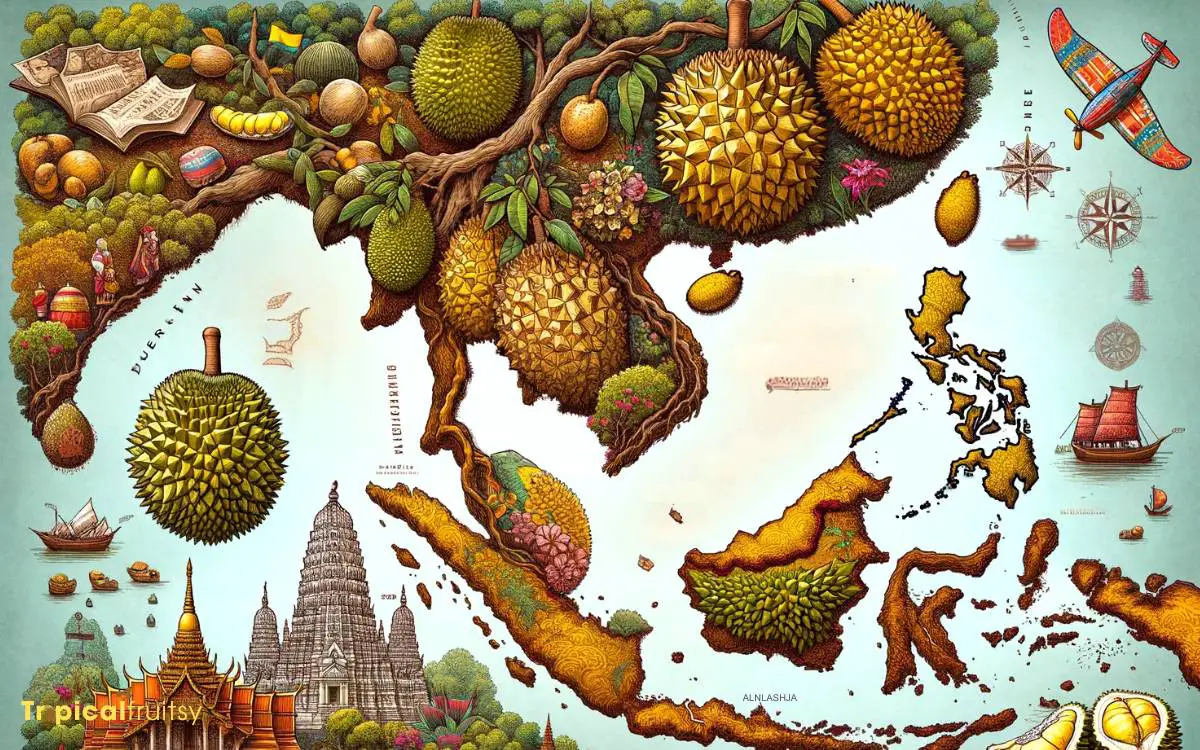
The durian fruit, hailed as the ‘king of fruits’ in Southeast Asia, has its origins in the tropical forests of the region.
This thorny, pungent fruit is believed to have been cultivated for over a thousand years, yet its domestication history remains somewhat obscure.
The genus Durio comprises approximately 30 known species, but only a handful have been domesticated for consumption.
The primary species, Durio zibethinus, commands widespread cultural significance and economic importance across Southeast Asia.
Scholarly analysis of durian’s genetic diversity indicates a rich, complex lineage, suggesting ancient dispersal and cultivation by indigenous peoples.
Agricultural practices have evolved to sustain and propagate high-value cultivars, reflecting a deep understanding of the fruit’s ecological and biological requirements within its native habitat.
Historical Significance in Cultures
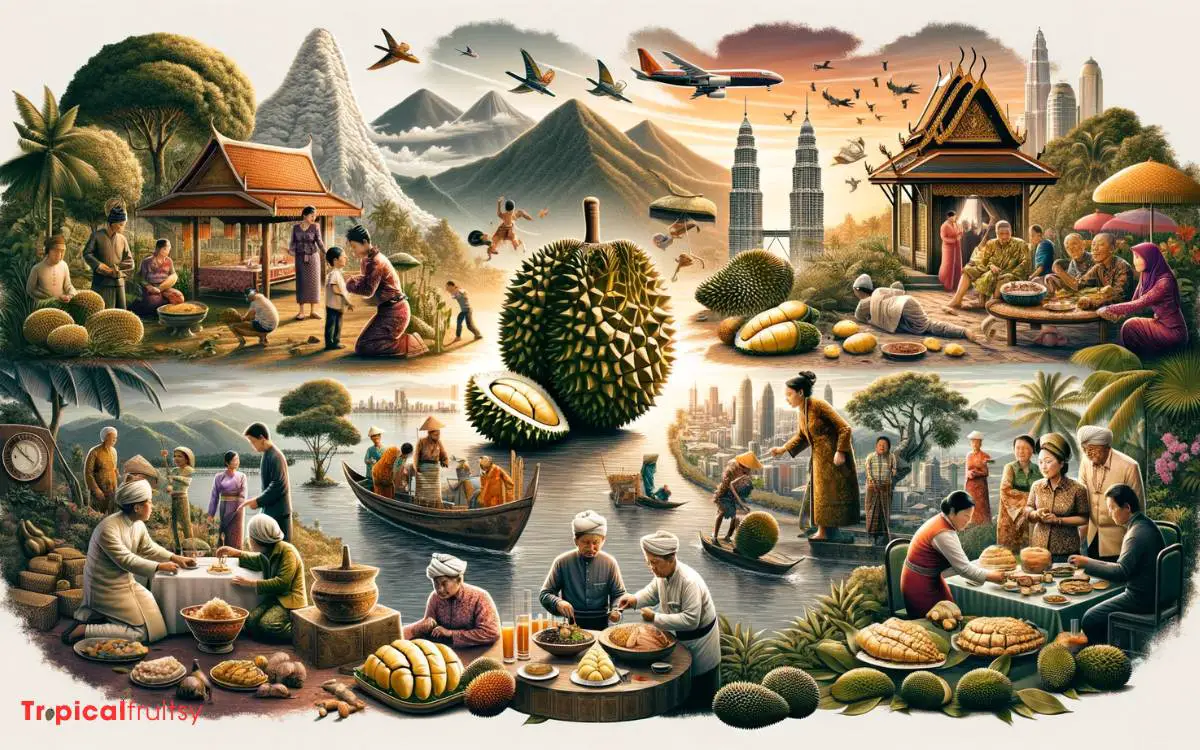
Durian has long held a revered place in the social and cultural tapestries of various Southeast Asian communities.
To analyze its historical significance, one must consider the durian’s symbolic presence, where it often conveys a sense of identity and continuity.
In traditional ceremonies, the durian is more than a fruit; it is an emblem of abundance and community spirit. Its role is deeply embedded in local folklore and social rituals, which are pivotal in shaping cultural consciousness.
| Culture | Significance | Emotional Response |
|---|---|---|
| Malay | Symbol of hospitality | Warmth and Generosity |
| Thai | Celebratory feast staple | Joy and Togetherness |
| Indonesian | Mythological associations | Wonder and Tradition |
The Geography of Durian Growth
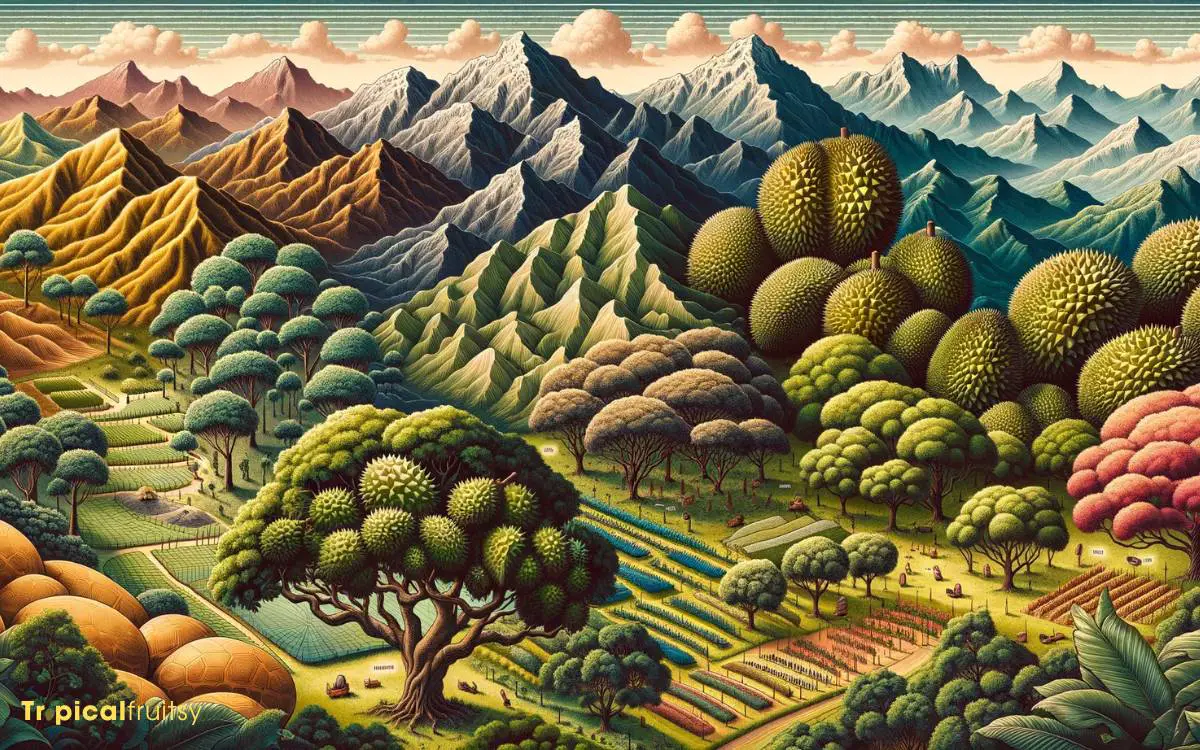
The distribution and cultivation of Durian fruit are inextricably linked to specific geographic and climatic conditions that define its native and cultivated ranges.
Southeast Asia, particularly countries like Malaysia, Thailand, and Indonesia, is recognized as the native region where durian thrives, with its growth heavily reliant on warm temperatures, high humidity, and well-drained soils.
A comprehensive analysis of these climatic requirements is essential to understand the limitations and potential for expanding durian cultivation within and beyond these native boundaries.
Native Regions
Southeast Asia is the native region where durian trees, known for their distinctively pungent fruits, flourish in tropical conditions.
The genus Durio includes approximately 30 species, but only nine of them produce edible fruits, with Durio zibethinus being the most commercially cultivated.
These species are indigenous to various Southeast Asian countries, including Malaysia, Indonesia, and Thailand, which collectively contribute to the majority of global durian production.
The durian’s endemic habitat is characterized by biodiverse rainforests, where the species occupies ecological niches ranging from lowland regions to hilly terrains up to elevations of approximately 800 meters.
The proliferation of durian cultivation within its native range can be attributed to both natural propagation and human agricultural practices.
Understanding the geographic origins of the durian fruit provides a foundation for exploring the specific climatic requirements that enable its growth, which is the focus of the following section.
Climate Requirements
Optimal growth of durian trees necessitates a humid, tropical climate with abundant rainfall and temperatures ranging consistently between 22°C and 35°C.
These conditions are quintessential for the tree’s development, from seed germination to fruit maturation.
Climate Specifics:
- Temperature: 22°C to 35°C for enzymatic and metabolic processes.
- Humidity: High, to facilitate nutrient uptake and transpiration.
- Rainfall: Heavy and regular, to meet the water demands of the durian’s extensive root system.
The geographical distribution of durians is consequently confined to areas where these climatic conditions prevail, underscoring the fruit’s limited cultivation outside native regions.
The precise combination of temperature, humidity, and rainfall is critical for the tree to thrive and produce the characteristic fruit.
This segues into a discussion on the specific climatic needs for durian trees, which dictate their global agricultural potential.
Climatic Needs for Durian Trees

Durian trees exhibit a stringent preference for equatorial tropics, where consistent thermal conditions, with temperatures rarely dipping below 22°C, are imperative for their physiological processes.
Elevated humidity levels, typically above 75%, are crucial to sustain the turgor pressure within the plants’ cells, facilitating vital functions such as nutrient transport and photosynthesis.
Furthermore, durian trees demand substantial precipitation, in the range of 1500 to 3000 mm annually, to support their growth cycles and fruit production.
Tropical Warmth Required
Although durian trees are native to Southeast Asia, they demand a year-round tropical climate to thrive, characterized by high temperatures and consistent rainfall.
The cultivation of Durio species, particularly Durio zibethinus, is critically dependent on specific climatic conditions.
Temperature Requirements:
- Optimal range: 24°C to 30°C (75°F to 86°F)
- Minimal cold tolerance
- Vulnerability to frost
Rainfall Necessities:
- Annual precipitation: 1,500 to 3,000 mm
- Importance of water for fruit development
- Sensitivity to prolonged dry periods
Humidity and Soil Conditions:
- High humidity levels: 75% to 80% preferred
- Well-drained, fertile loamy soils
- pH range: slightly acidic to neutral
These parameters delineate the geographical limitations and the potential for successful durian cultivation, which is predominantly restricted to equatorial regions.
High Humidity Levels
Maintaining high humidity levels is crucial for durian trees, as they require a moist environment to support their growth and fruit production.
Durian trees thrive in conditions where atmospheric moisture is consistently high, typically above 80% relative humidity.
This high humidity is necessary to prevent the delicate flowers and developing fruits from desiccating, which can lead to a reduced yield or fruit drop.
The trees’ transpiration rates are adjusted to these moisture-abundant environments, facilitating nutrient uptake and photosynthetic efficiency.
Moreover, high humidity aids in maintaining the soil moisture balance, which is vital for the health of the tree’s root system.
As we segue into the importance of precipitation, it becomes apparent that abundant rainfall is essential for sustaining the high humidity levels that durian trees demand for optimal growth.
Abundant Rainfall Essential
In regions native to durian trees, an annual rainfall exceeding 1,500 millimeters is essential to meet the climatic needs of these fruit-bearing plants.
The precise distribution and frequency of rainfall are critical factors influencing durian tree growth and fruit development.
An analytical examination of these requirements yields the following insights:
Climatic Prerequisites for Durian Cultivation:
- Optimal Rainfall Pattern: Consistent rainfall during the growing season ensures adequate soil moisture.
- Dry Season Impact: A distinct dry period is necessary to stimulate flowering.
- Water Stress Avoidance: Excessive or insufficient rainfall can lead to physiological stress, affecting yield quality and quantity.
The interplay of these elements underpins the durian’s reputation as a crop heavily reliant on specific environmental conditions.
Expansion Across Asian Borders
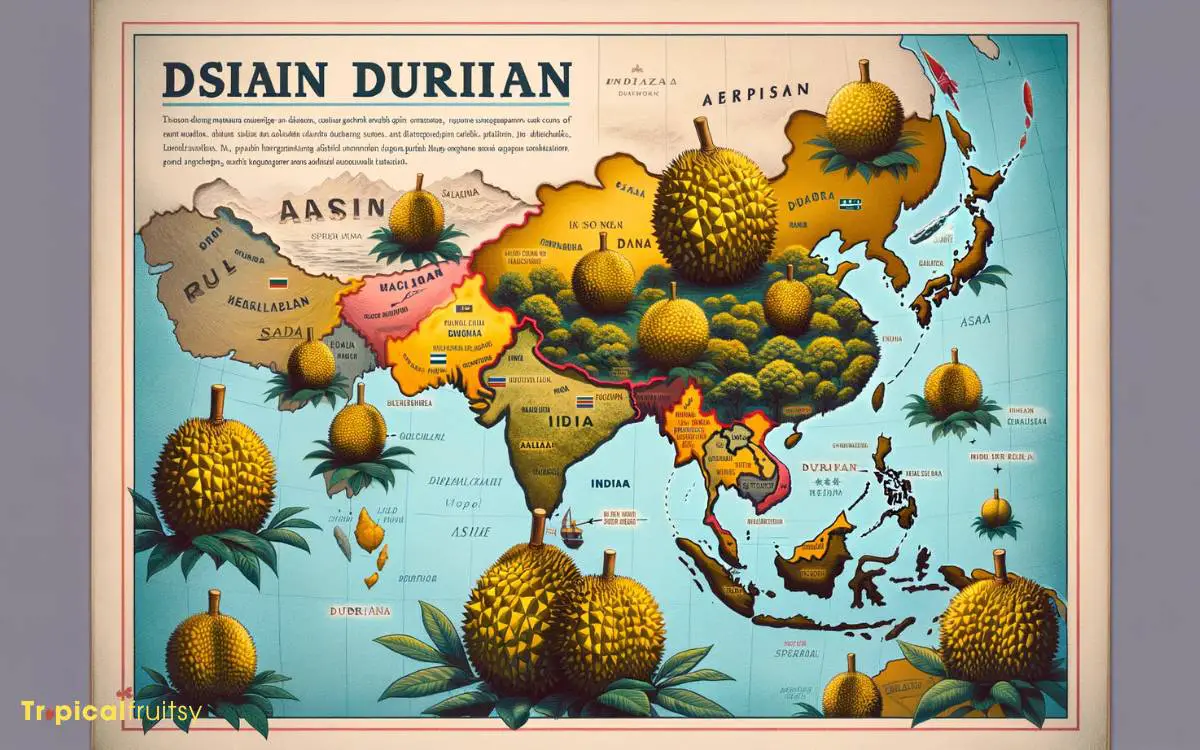
How did durian, originally native to Southeast Asia, proliferate throughout neighboring Asian countries? This expansion can be attributed to several factors, including migration, trade, and the fruit’s increasing popularity.
As people moved for trade or other reasons, they brought durian seeds with them, cultivating the fruit in new areas.
Additionally, the rising demand for durian’s unique taste and supposed health benefits led to its cultivation beyond its native habitat.
To illustrate, consider the following table highlighting key aspects of durian’s proliferation:
| Country | Impact on Durian Expansion |
|---|---|
| China | Increased demand, investment in farms |
| Thailand | Major exporter, advanced cultivation techniques |
| Vietnam | Climatically favorable, growing export market |
| Malaysia | Biodiversity conservation, tourism attraction |
| Indonesia | Genetic diversity, large-scale plantations |
Durian in the Western World
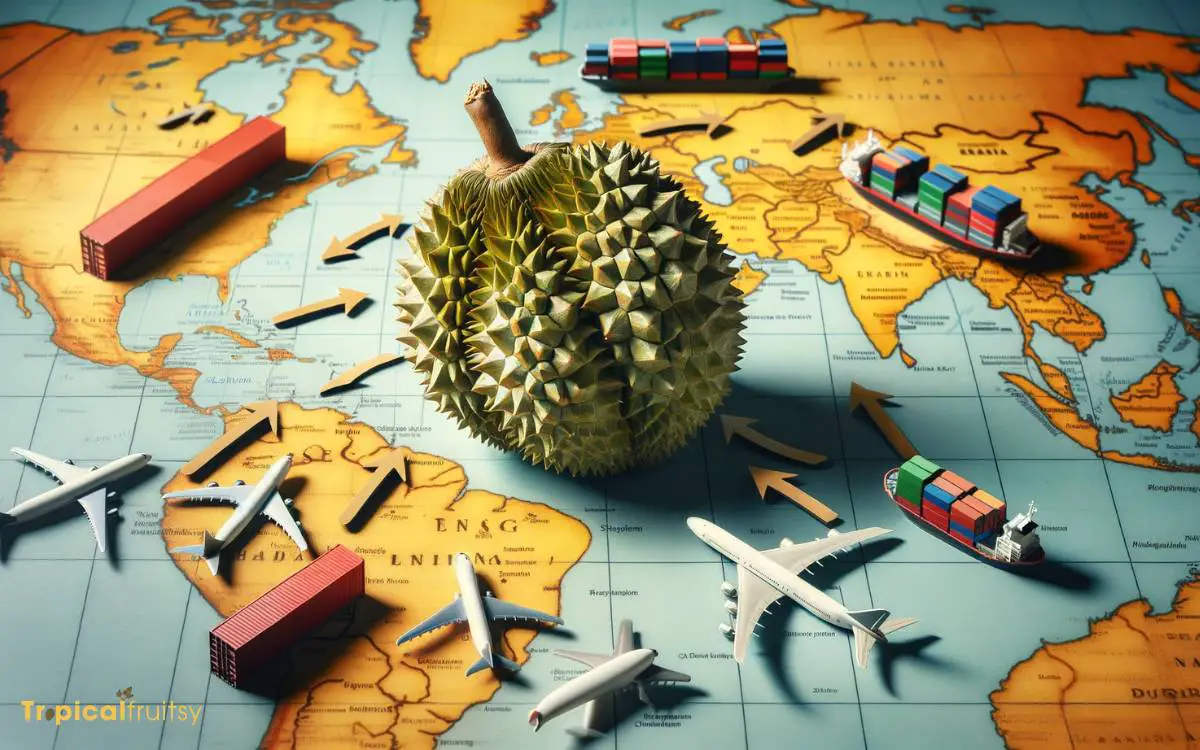
Durian consumption in the Western World has seen a notable increase, reflecting global culinary curiosity and the fruit’s exotic appeal.
This trend is not merely a fad but is underpinned by several factors that deserve closer examination:
Increased exposure through:
- Social media platforms showcasing exotic foods
- Travel experiences of Westerners in Southeast Asia
Availability facilitated by:
- Globalization of trade, allowing durian to be exported
- Specialty Asian markets in western cities
Cultural integration because of:
- Growing Asian expatriate communities in the West
- Culinary adventurers seeking novel taste experiences
The analytical approach to understanding the rise in durian’s popularity in the West must consider these multifaceted drivers.
They collectively contribute to the fruit’s journey from its native Southeast Asian origins to the shelves of Western markets.
Current Global Durian Trade

Reflecting its growing popularity in the West, the global durian trade has expanded significantly, with Southeast Asia leading as the primary exporter of this distinctive fruit.
Thailand, Malaysia, and Indonesia are principal players, underpinned by robust production capacities and extensive agricultural infrastructure.
The trade has been invigorated by rising demand from China, where durian is esteemed as a symbol of affluence and cultural prestige.
Advanced preservation techniques, such as flash freezing, have facilitated the fruit’s international transport, ensuring that quality is maintained across vast distances.
Meanwhile, export strategies have become increasingly sophisticated, with countries establishing durian festivals and leveraging e-commerce platforms to penetrate new markets.
Consequently, the global market dynamics are shifting, with supply chains being recalibrated to accommodate the durian’s burgeoning international appetite.
Conclusion
In summary, the durian, with its formidable aroma and formidable cultural stature, has extended its roots far beyond its Southeast Asian cradle.
Like Odysseus, whose legend transcended ancient shores, durian’s influence and commercial presence now navigate the complexities of global trade and palates.
It stands as a symbol of both regional pride and international curiosity, proving that even the most divisive of fruits can achieve a form of universal recognition and economic significance.




